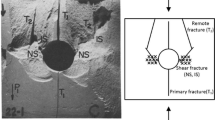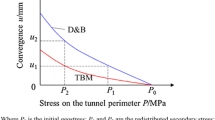Abstract
Underground excavation normally causes instability of the mother rock due to the release and redistribution of stress within the affected zone. For gaining deep insight into the characteristics and mechanism of rock crack evolution during underground excavation, laboratory tests are carried out on 36 man-made rock specimens with single or double cracks under two different unloading conditions. The results show that the strength of rock and the evolution of cracks are clearly influenced by both the inclination angle of individual cracks with reference to the unloading direction and the combination geometry of cracks. The peak strength of rock with a single crack becomes smaller with the inclination angle. Crack propagation progresses intermittently, as evidenced by a sudden increase in deformation and repeated fluctuation of measured stress. The rock with a single crack is found to fail in three modes, i.e., shear, tension–shear, and splitting, while the rock bridge between two cracks is normally failed in shear, tension–shear, and tension. The failure mode in which a crack rock or rock bridge behaves is found to be determined by the inclination angle of the original crack, initial stress state, and unloading condition. Another observation is that the secondary cracks are relatively easily created under high initial stress and quick unloading.















Similar content being viewed by others
References
Adams M, Sines G (1978) Crack extension from flaws in a brittle material subjected to compression. Tectonophysics 49(1–2):97–118
Brady BHG, Brown ET (2007) Rock mechanics: for underground mining. Kluwer, Dordrecht
Cai M, Kaiser PK (2005) Assessment of excavation damaged zone using a micromechanics model. Tunn Undergr Space Technol 20:301–310
Gambarotta L (1993) Modeling dilatancy and failure of uniaxially compressed brittle materials by microcrack-weakened solids. Eng Fract Mech 46:381–391
Gambarotta L, Monetto I (2002) Uniaxial compressive failure of brittle materials as instability of damaging microcracked solids. Eur J Mech A/Solids 21:121–132
Gong QM, Yin LJ, Wu SY, Zhao J, Ting Y (2012) Rock burst and slabbing failure and its influence on TBM excavation at headrace tunnels in Jinping II hydropower station. Eng Geol 124(4):98–108
He MC, Miao JL, Feng JL (2010) Rock burst process of limestone and its acoustic emission characteristics under true-triaxial unloading conditions. Int J Rock Mech Min Sci 47(2):286–298
Huang RQ (2012) Mechanisms of large-scale landslides in China. Bull Eng Geol Environ 71(1):161–170
Huang RQ, Wang XN, Chan LS (2001) Triaxial unloading test of rocks and its implication for rock burst. Bull Eng Geol Environ 60(1):37–41
Kilburn CRJ, Petley DN (2003) Forecasting giant, catastrophic slope collapse: lessons from Vajont, Northern Italy. Geomorphology 54(1–2):21–32
Lei XL, Kusunose K, Rao MVMS, Nishizawa O, Satoh T (2000) Quasi-static fault growth and cracking in homogeneous brittle rock under triaxial compression using acoustic emission monitoring. J Geophys Res 105(B3):6127–6139
Li JL, Meng QY (2001) Anisotropic study of unloaded rock mass. Chin J Rock Mech Eng 23(3):338–341 (in Chinese)
Ministry of Water Resources of the People’s Republic of China (2001) Specifications for rock tests in water conservancy and hydroelectric engineering. SL264-2001. China Water Power Press, Beijing (in Chinese)
Post G, Bonazzi D (1987) Latest thinking on the Malpasset accident. Eng Geol 24(1–4):339–359
Xie HQ, He CH (2004) Study of the unloading characteristics of a rock mass using the triaxial test and damage mechanics. Int J Rock Mech Min Sci 41(3):366
Zhang ZY, Wang ST, Wang LS (1994) Principles of engineering geology. Geological Publishing House, Beijing (in Chinese)
Zhu WS, Chen WZ, Shen J (1998) Simulation experiment and fracture mechanism study on propagation of echelon pattern cracks. Acta Mech Solida Sin 19(4):355–360 (in Chinese)
Acknowledgments
This work is supported by the National Natural Science Foundation of China (No. 41130745 and No. 41172243), the Fundamental Research Funds for the Central Universities (No. CDJZR12205501), and the Open Foundation of State Key Laboratory of Geohazard Prevention and Geoenvironment Protection (No. SKLGP2011K003). The authors are deeply grateful to Dr. Yanrong Li of AGECON Ltd. (Hong Kong) for his valuable comments on and constructive revision of the paper, and stimulating discussions on the research.
Author information
Authors and Affiliations
Corresponding author
Rights and permissions
About this article
Cite this article
Huang, R.Q., Huang, D. Evolution of Rock Cracks Under Unloading Condition. Rock Mech Rock Eng 47, 453–466 (2014). https://doi.org/10.1007/s00603-013-0429-0
Received:
Accepted:
Published:
Issue Date:
DOI: https://doi.org/10.1007/s00603-013-0429-0




